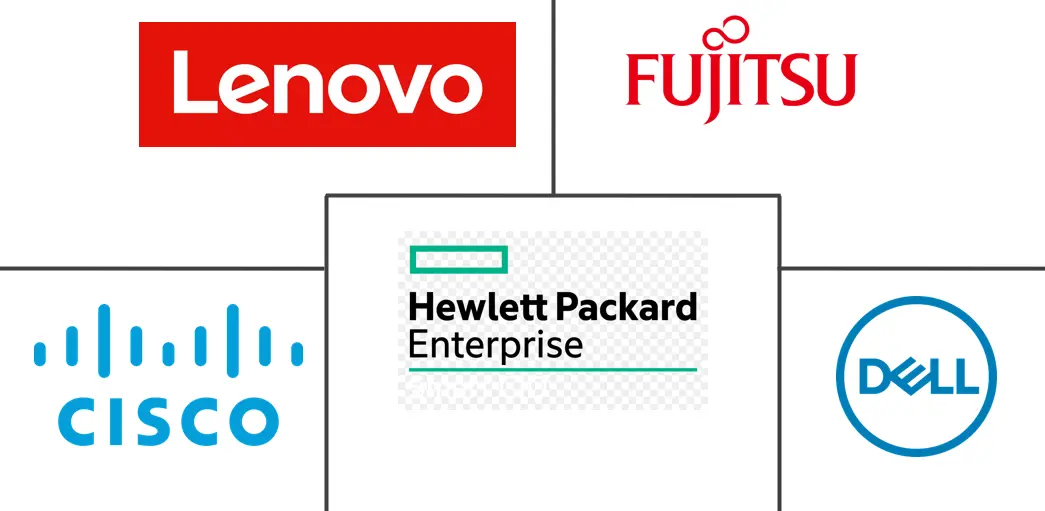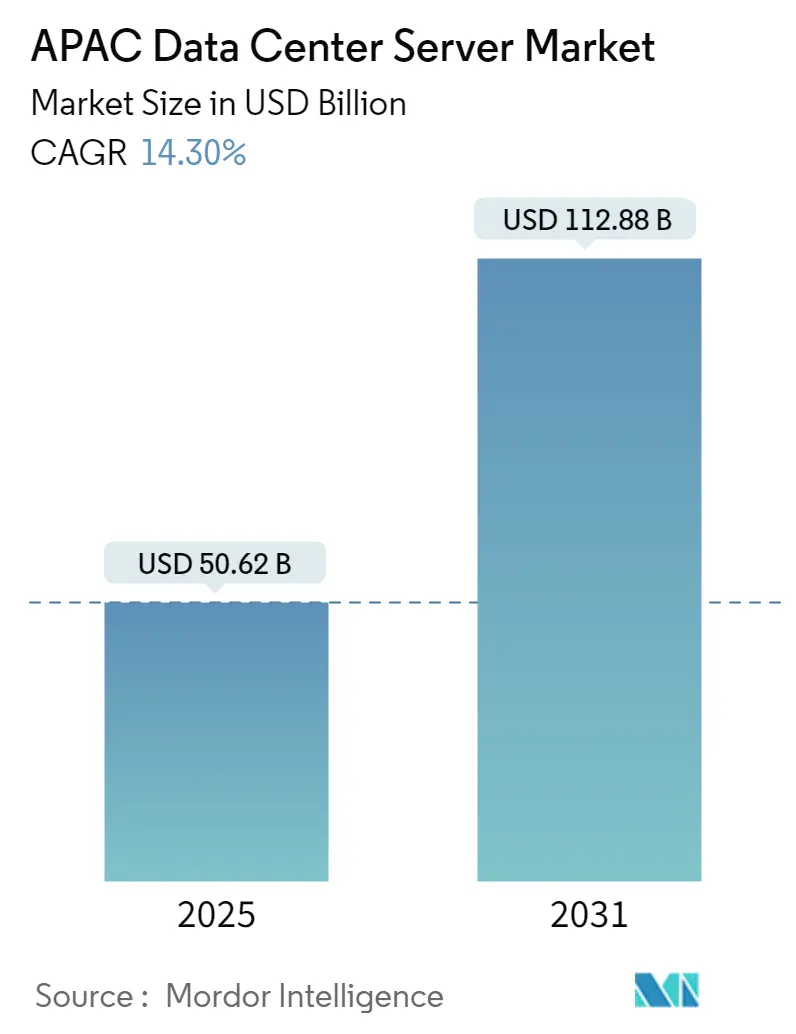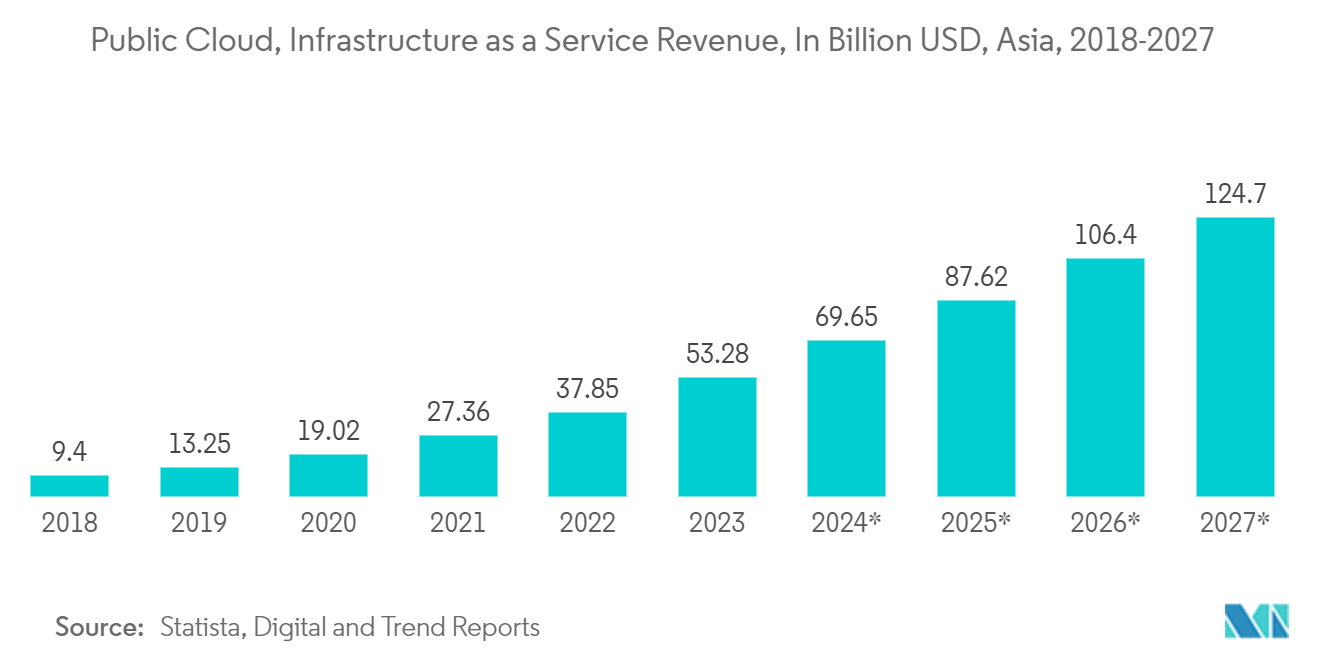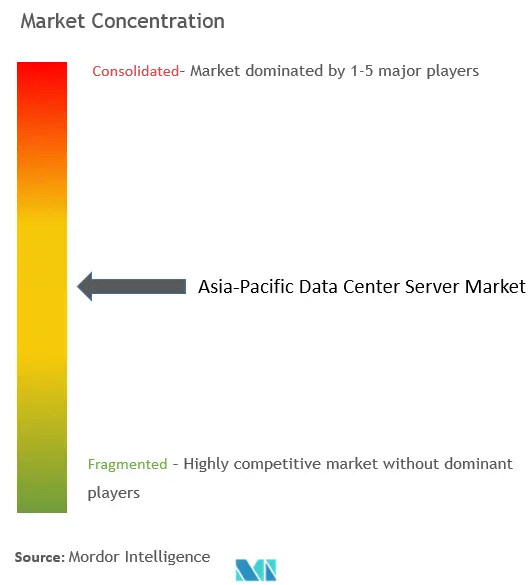APAC Data Center Server Market Analysis
The APAC Data Center Server Market size is estimated at USD 50.62 billion in 2025, and is expected to reach USD 112.88 billion by 2031, at a CAGR of 14.3% during the forecast period (2025-2031).
The increasing demand for cloud computing among small and medium-sized enterprises (SMEs), government regulations for local data security, and growing investment by domestic players are some of the major factors driving the demand for data centers in the region.
- The upcoming IT load capacity of the Asia-Pacific data center construction market is expected to reach 23K MW by 2029.
- The region's construction of raised floor area is expected to increase 74.5 million sq. ft by 2029.
- The region's total number of racks to be installed is expected to reach 4.2 million units by 2029. India is expected to house the maximum number of racks by 2029.
- There are close to 160 submarine cable systems connecting the Asia-Pacific, and many are under construction. One such submarine cable that is estimated to start service in 2024 is Southeast Asia-Japan Cable 2 (SJC2), which stretches over 10,500 Kilometers with a landing point in China, Taiwan, Japan, South Korea, Thailand, and Vietnam.
APAC Data Center Server Market Trends
IT & Telecommunication Segment Holds the Major Share.
- The increasing adoption of cloud-based services is driving the expansion of hyperscale colocation services in the region, resulting in increased demand for space in data centers and, consequently, the need for more servers within data centers.
- The demand for cloud services is promising in Vietnam, Thailand, and other Southeast Asian countries. Thailand will adopt hybrid cloud services rapidly over the next five years, with 67% of the respondents in Thailand having agreed upon the adoption plan. The country's leading cloud customers include those in the digital media, finance, retail, and manufacturing sectors. In Vietnam, the rollout of 5G networks is expected to boost the region's digital economy and lead to increased demand for high-bandwidth network infrastructure.
- In Australia, currently, about 10-15% of data is created and processed outside a centralized data center or cloud, but the number is expected to cross 60-70% by 2025, a global trend that is also reflected in Australia. Thus, edge data centers are becoming more viable options for Australian vendors, especially startups. Overall, the market is expected to showcase a major growth rate during the forecast period.
- The Chinese cloud market is expected to grow from USD 30 billion in 2021 to USD 90 billion by 2025 due to the rising demand for cloud computing services. Cloud computing services are delivered to the users in the form of Software-as-a-Service (SaaS), Platform-as-a-Service (PaaS), and Infrastructure-as-a-Service (IaaS).
- Developments such as increasing adoption of cloud services, expansion of 5G Networks, and the ongoing demand for online payments are, in turn, expected to boost the demand for the data center market from the IT and telecom segment, leading to the significant need for the servers during the forecast period.
India is Expected to Have Significant Market Share in The Coming Years
- India is among the major players in the data center sector in the APAC region. The mobile data speed in India is expected to increase from 20.10 Mbps in 2022 to 38.30 Mbps by 2029, registering a CAGR of 8.9%. The arrival of Jio Telecom in the Indian Internet market offered users increased data speeds and low latency. This increased data consumption by users was owing to streaming online content, playing high-quality graphic online games, teleconsultation, and social media video conferencing apps.
- A majority of the current data centers are being built in Mumbai, Chennai, and Hyderabad. The Central and State governments came up with draft data center policies and incentives. Some states like Uttar Pradesh and Telangana have rolled out the policies already. As resources like power and water have become even more scarce in India, market players will strive to make cleaner and greener data centers than ever before. The cooling and supporting backup infra components will evolve into more efficient and cleaner options.
- In terms of policy, the Government of India and various state governments are revising their data center policies to support the infrastructural growth of data centers in India through tax subsidies. Under a national policy framework for data centers, the IT ministry intends to provide up to INR 15,000 crore ( USD 1,812 million) as incentives. The government plans to invest up to INR 3 lakh crore (USD 0.036 Trillion) in the data center ecosystem over the next five years, as per the policy.
- The spread of the Internet and smartphones has progressed rapidly in India in recent years. As reported by the Department of Telecommunications (India), the total number of internet connections in India approached 851 million in the financial year 2023. This marks a near tripling of connectivity since 2015, when there were only 302.33 million connections. Despite approximately 70% of India's population residing in rural regions, urban areas boast a higher number of connections. In 2023, urban areas accounted for 507 million internet connections.
APAC Data Center Server Industry Overview
The upcoming DC construction projects in the region will increase the demand for data center servers in the coming years. The Asia-Pacific data center server market is moderately consolidated, with a few major players, such as Dell Inc., Hewlett Packard Enterprise, Fujitsu, and Lenovo Group Limited. These major players, with a prominent market share, focus on expanding their regional customer base.
In August 2023, Dell Inc. is transitioning its servers with Next-generation Dell PowerEdge Servers from OSA to ESA with PowerEdge R760 powered by 4th generation Intel Xeon Processors.
In January 2023, Cisco announced the launch of the 7th generation of UCS C-Series and X-Series servers, powered by 4th generation Intel Xeon scalable processors. With support for the latest Intel processors, Cisco has launched two new blades for the X-Series: the Cisco UCS X210c M7 Compute Node and the Cisco UCS X410c M7 Compute Node.
APAC Data Center Server Market Leaders
-
Dell Inc.
-
Hewlett Packard Enterprise
-
Lenovo Group Limited
-
Fujitsu
-
Cisco Systems Inc.
- *Disclaimer: Major Players sorted in no particular order
APAC Data Center Server Market News
- August 2023: Hewlett Packard Enterprise has announced that, with cloud HPE ProLiNative RL300 Gen11 servers based on energy-efficient processors from Ampere Computing, PhoenixNAP, the world's leading IT service provider, expanded its bare metal cloud platform. With increased performance and energy efficiency, the expansion of services is intended to support artificial intelligence (AI) inferencing, cloud gaming, and any other workloads based on a "cloud-native" architecture. Also, it enables phoenixNAP to provide next-generation computing performance with energy consumption savings.
- January 2023: Supermicro announced the launch of its new server and storage portfolio with more than 15 families of performance-optimized systems focusing on cloud computing, AI, and HPC, as well as enterprise, media, and 5G/telco/edge workloads. SuperBlade would deliver the computational performance of a whole server rack in a considerably smaller physical footprint by using shared, redundant components, including cooling, networking, power, and chassis management. These blade server systems are geared for AI, Data Analytics, HPC, Cloud, and Enterprise applications and feature GPU-enabled blades.
APAC Data Center Server Industry Segmentation
A data center server is basically a high-capacity computer without peripherals like monitors and keyboards. It is a hardware unit installed inside a rack, having a central processing unit (CPU), storage, and other electrical and networking equipment, making them powerful computers that deliver applications, services, and data to end-user devices.
The Asia-Pacific data center server market is segmented by form factor (blade server, rack server, and tower server), by end-user (IT and telecommunication, BFSI, government, media and entertainment, and other end users), and by geography (Indonesia, India, China, Australia, South Korea, Philippines, Thailand, Singapore, New Zealand, Japan, Malaysia, Vietnam, Hong Kong, Taiwan, and Rest of Asia Pacific). The Market Sizes and Forecasts are Provided in Terms of Value (USD) for all the Above Segments.
| Form Factor | Blade Server |
| Rack Server | |
| Tower Server | |
| End-User | IT & Telecommunication |
| BFSI | |
| Government | |
| Media & Entertainment | |
| Other End-User | |
| ***Geography | Indonesia |
| India | |
| China | |
| Australia | |
| South Korea | |
| Philippines | |
| Thailand | |
| Singapore | |
| New Zealand | |
| Japan | |
| Malaysia | |
| Vietnam | |
| Hong Kong | |
| Taiwan |
APAC Data Center Server Market Research Faqs
How big is the APAC Data Center Server Market?
The APAC Data Center Server Market size is expected to reach USD 50.62 billion in 2025 and grow at a CAGR of 14.30% to reach USD 112.88 billion by 2031.
What is the current APAC Data Center Server Market size?
In 2025, the APAC Data Center Server Market size is expected to reach USD 50.62 billion.
Who are the key players in APAC Data Center Server Market?
Dell Inc., Hewlett Packard Enterprise, Lenovo Group Limited, Fujitsu and Cisco Systems Inc. are the major companies operating in the APAC Data Center Server Market.
What years does this APAC Data Center Server Market cover, and what was the market size in 2024?
In 2024, the APAC Data Center Server Market size was estimated at USD 43.38 billion. The report covers the APAC Data Center Server Market historical market size for years: 2019, 2020, 2021, 2022, 2023 and 2024. The report also forecasts the APAC Data Center Server Market size for years: 2025, 2026, 2027, 2028, 2029, 2030 and 2031.
Our Best Selling Reports
APAC Data Center Server Industry Report
Statistics for the 2025 APAC Data Center Server market share, size and revenue growth rate, created by Mordor Intelligence™ Industry Reports. APAC Data Center Server analysis includes a market forecast outlook for 2025 to 2031 and historical overview. Get a sample of this industry analysis as a free report PDF download.







